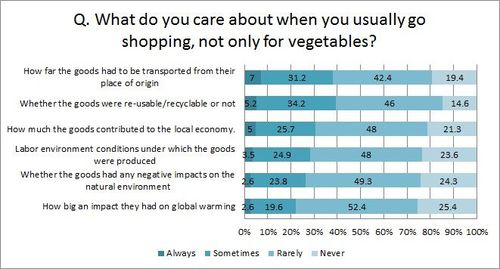March 17, 2015
Everyday Shopping Can Promote Local Economies, Says JFS Survey
Keywords: Civil Society / Local Issues Newsletter
JFS Newsletter No.150 (February 2015)
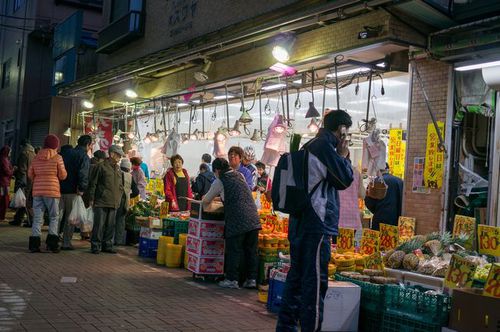
Image by yamauchi Some Rights Reserved.
There was a shocking prediction that made headlines all over Japan in May 2014, that a total of 896 municipalities across Japan might disappear by 2040 due to population decline and their inability to maintain administrative functions. The prediction, part of the "Masuda Report" compiled by former Internal Affairs and Communications Minister Hiroya Masuda, is one of many that typically show Japanese local municipalities to be in difficult circumstances. The government is addressing this national challenge, not only at the local level but also at the national level, by establishing the Headquarters for Overcoming Population Decline and Vitalizing Local Economy under the Cabinet Office.
Japan for Sustainability held a symposium on February 9, 2015, titled "Community Initiatives for Survival--from a Local Economy and Regional Revitalization Perspective." So many people attended that a few even had to stand. This indicates increasing public attention to this issue.
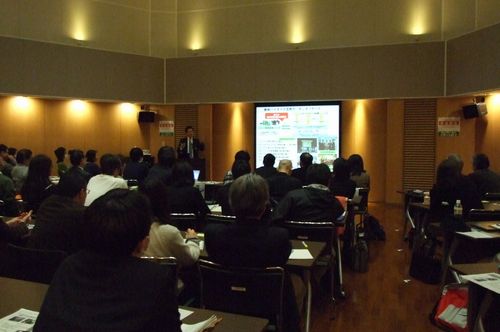
JFS symposium "Community Initiatives for Survival--
from a Local Economy and Regional Revitalization Perspective."
Everyday Shopping Can Support Local Economies
As such discussions proceed, the question always arises of how to involve the general public in these discussions and projects. How can we promote and support our local economy as citizens in the community?
One way would be to participate in municipal projects and meetings for promoting local economies, but there is a more familiar activity anyone can do every day -- go shopping.
For example, a study targeting Cornwall, U.K. indicated that if every tourist, resident or business switched just 1 percent of their spending to local items or services, it would put 52 million pounds (about US$80.8 million) of additional direct spending into the local economy every year. (New Economics Foundation, 2002, "Plugging the Leaks" p. 7 ).
Even if people shop locally, stores belonging to chains headquartered elsewhere send a not-so-small portion of the money they receive to their headquarters outside the area. On the other hand, when people buy things at locally owned shops, the money stays in the local area. When stores procure locally, the money goes to local companies, and if they employ people locally, the money pays local residents' salaries. As people in the area use local items and local human resources, the money is cycled within the region many times, potentially generating several-fold economic benefits. (For a more detailed, easy-to-follow explanation of this idea, called "the local multiplier effect," see "Plugging the Leaks" by the New Economic Foundation.)
In this way, anybody can contribute to a prosperous local economy through everyday shopping. JFS considers it important to disseminate this idea to general consumers.
Survey on Communities and Consumer Behavior
Based on the local multiplier effect concept, in December 2014, JFS conducted a survey, funded by the Patagonia Environmental Grants Program, of communities and consumer behavior. Conducted from December 22 to 24 by the Japanese online research company Macromill Inc., the survey was completed by 1,000 citizens in their twenties through seventies who had registered with the company as monitors. The percentages of the sample population selected for the survey in terms of age, gender and residence in metropolitan areas, mid-to-small sized local cities, and rural areas were made proportionate to the demographics identified by Japan's national census.
Patagonia Environmental Grants Program
http://www.patagonia.com/us/patagonia.go?assetid=2942
We present here the responses to three questions from this survey: "Do we need to change our local economy?" "Where do you buy vegetables or where would you want to buy them?" and "What do you care about in your everyday shopping?"
Do we need to change our local economy?
To the first question, about 40 percent answered "we need to change the current situation," greatly exceeding those who thought there was no need to change (about 16 percent).
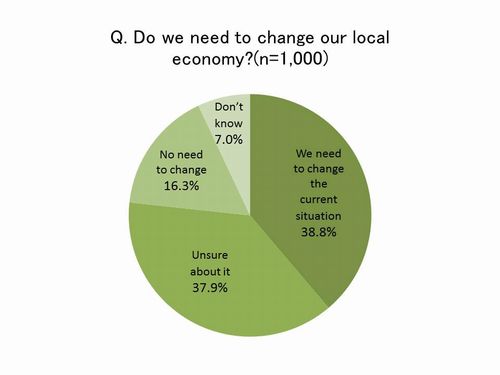
The survey then asked people to list local problems and consider measures against those problems in an open-ended question. Their comments identified structural problems such as the declining birth rate and aging population, and changes in industrial structure (population decrease due to relocation of universities and businesses). Respondents mentioned community building to attract young people and creation of elderly-friendly communities as measures against the declining birth rate and aging population.
As for local stores, some replied that it would be necessary to attract chains or large-scale retail stores, but others said that big shopping malls would have a catastrophic effect on local stores and that shopping malls had few unique stores.
The survey also asked about possible countermeasures for preserving local industries and stores. Some respondents mentioned local shopping or employment and others suggested nurturing industries that capitalize on distinctive local features. The results showed that some people thought it was possible for each citizen to promote the local economy.
Where do you buy vegetables or where would you want to buy them?
The survey asked respondents where they actually bought vegetables and where they would ideally like to buy them.
To the question about where and how often they bought vegetables, a majority of over 80 percent responded, "I buy vegetables at a supermarket more than once a week." The second most common response was "convenience stores" (about 25 percent). About 13 percent of respondents shopped at greengrocers more than once a week, about 12 percent at Japanese Consumer Co-operatives (co-ops) and about 10 percent at farm stands. In many cases, respondents' reasons for buying vegetables at each place were that it was "near" or "convenient."
Regarding consumers' "ideals," the survey then asked respondents for multiple responses about where they would like to buy vegetables. Again the top reply was supermarkets, which about 90 percent selected as a place where they "want to buy vegetables." Farm stands came in second, with about 44 percent, and greengrocers, third, with about 40 percent. The results show that not a few people would like to buy vegetables at farmers' markets or greengrocers.
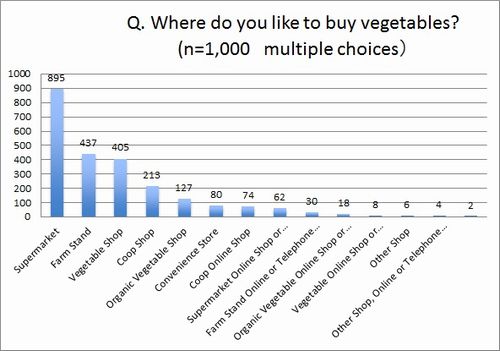
As to why they wanted to buy vegetables at those shops, some answered, "I can enjoy talking with the shopkeepers while shopping," and "I try to buy locally and consume locally." On the other hand, those who favored supermarkets replied, "Their opening hours are longer," "They offer packages with small portions," and "I can get various things, not just vegetables." Some also said they shopped at supermarkets "because all the family-run shops went out of business in my neighborhood."
From these results, we see that some people hope ideally to buy vegetables at local greengrocers or farm stands, but shop at supermarkets in reality, because there are no local shops or stands nearby, or those small shops are not open late at night, or they want to buy only in small amounts, or they can get other goods in addition to vegetables at supermarkets.
What do you care about in your everyday shopping?
Finally, on the third question, "What do you care about when you usually go shopping, not only for vegetables?" we asked the respondents to rate how much they cared about each of the following six points: whether the goods were re-usable/recyclable or not, how far the goods had to be transported from their place of origin, how big an impact they had on global warming, whether the goods had any negative impacts on the natural environment, labor environment conditions under which the goods were produced, and how much the goods contributed to the local economy.
The results showed that the respondents' top two concerns, that they "always/sometimes" cared about, were whether the goods were re-usable/recyclable or not (about 39 percent) and how far the goods were being transported (about 38 percent). Regarding contribution to the local economy, about 33 percent cared "always/sometimes" about the concern, "Can the money I pay help the local economy?"
Conclusion
From this survey, we found that a certain number of people, in their replies to an open-ended question, recognized the idea of helping enrich the local economy through the money they spent shopping. We also found that many considered local production for local consumption desirable.
In the meantime, though, we can see that in reality it is not easy to shop at small local shops partly because "there are no such shops nearby" or "they are not open until late at night." We think such comments from consumers could be of use in community renovation.
JFS will work to convey, not only to consumers but also to various people engaged in community renovation, that money spent shopping can help enrich local economies. At the same time, we will also consider how to raise public awareness of individuals' contribution to their local economy through shopping and how to transform such awareness into action.
Written by Naoko Niitsu
Related
"JFS Newsletter"
- 'Good Companies in Japan' (Article No.4): 'Eightfold Satisfaction' Management for Everyone's Happiness
- "Nai-Mono-Wa-Nai": Ama Town's Concept of Sufficiency and Message to the World
- 'Yumekaze' Wind Turbine Project Connects Metro Consumers and Regional Producers: Seikatsu Club Consumers' Co-operative
- Shaping Japan's Energy toward 2050 Participating in the Round Table for Studying Energy Situations
- 'Good Companies in Japan' (Article No.3): Seeking Ways to Develop Societal Contribution along with Core Businesses


